
The Halton County Radial Railway is a working museum of electric streetcars, other railway vehicles, buses and trolleybuses. It is operated by the Ontario Electric Railway Historical Association (OERHA). It is focused primarily on the history of the Toronto Transit Commission (TTC) and its predecessor, the Toronto Transportation Commission, Its collection includes PCC, Peter Witt, CLRV and ALRV, and earlier cars from the Toronto streetcar system as well as G-series and M-series Toronto subway cars.

The Hamilton Street Railway (HSR) is the public transport agency for Hamilton, Ontario. The name is a legacy of the company's early period, when public transit in Hamilton was primarily served by streetcars. Although streetcars are no longer used in the city today, the HSR operates bus and paratransit services, with a ridership of 21 million passengers a year.

A horsecar, horse-drawn tram, horse-drawn streetcar (U.S.), or horse-drawn railway (historical), is an animal-powered tram or streetcar.

The Toronto Street Railway (TSR) was the operator of a horse-drawn streetcar system from 1861 to 1891 in Toronto, Ontario, Canada. Its successor, the Toronto Railway Company, inherited the horsecar system and electrified it between 1892 and 1894.
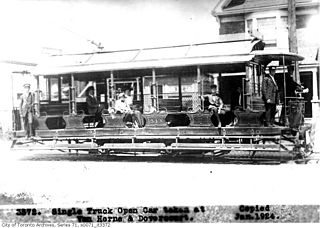
The Toronto Railway Company (TRC) was the operator of the streetcar system in Toronto between 1891 and 1921. It electrified the horsecar system it inherited from the Toronto Street Railway, the previous operator of streetcar service in Toronto. The TRC was also a manufacturer of streetcars and rail work vehicles, a few of which were built for other streetcar and radial operators.

The Toronto and York Radial Railway was a transit operator providing services to the suburbs of Toronto, Ontario, Canada. It was a subsidiary of the Toronto Railway Company. The company was created by merging four Toronto-area interurban operations. The company was part of the empire of railway entrepreneurs Sir William Mackenzie and Donald Mann which included the Canadian Northern Railway and the parent Toronto Railway Company. The line was abandoned by the TTC in 1948.
The Toronto Suburban Railway was a Canadian electric railway operator with local routes in west Toronto, and a radial (interurban) route to Guelph.

Toronto Civic Railways (TCR) was a streetcar operator created and owned by the City of Toronto, Ontario, Canada, to serve newly annexed areas of the city that the private operator Toronto Railway Company refused to serve. When the Toronto Railway Company's franchise expired in 1921, its services were combined with those of the Toronto Civic Railways, and are now assumed by the new Toronto Transportation Commission (TTC). The first route of the TCR started operation on December 18, 1912.
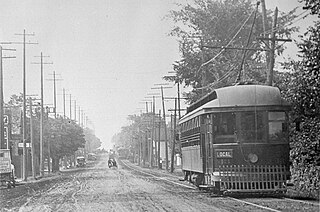
The Metropolitan line in the Toronto area, operated by the Metropolitan Street Railway, started out as a local horsecar line and transformed itself into an electric radial line extending to Lake Simcoe, following an old stage coach route. In 1904, the railway was acquired by the Toronto and York Radial Railway (T&YRR) and became the T&YRR Metropolitan Division. In 1922, the City of Toronto acquired the T&YRR and contracted Ontario Hydro to manage the four T&YRR lines including the Metropolitan. In 1927, the TTC took over the operation of the Metropolitan Line to Sutton, and renamed it the Lake Simcoe line. In 1930, the TTC closed the Metropolitan Line but shortly reopened the portion between Glen Echo and Richmond Hill operating it as the North Yonge Railways until 1948.

The North Yonge Railways was a radial railway line operated by the Toronto Transportation Commission from 1930 to 1948 between Glen Echo (Toronto) and Richmond Hill. The line was created by reopening the southern portion of the TTC's Lake Simcoe radial line that had closed in 1930.

The Guelph Transit Commission is a small public transportation agency that operates transit bus services in Guelph, Ontario, Canada. Established in 1929 after the closure of the Guelph Radial Railway Company streetcar lines, Guelph Transit has grown to comprise over 70 buses serving 28 transit routes.

The Fort Collins Municipal Railway operated streetcars in Fort Collins, Colorado, from 1919 until 1951. Since 1984, a section of one of the former routes has been in operation as a seasonal heritage streetcar service, under the same name, running primarily on Spring and Summer weekends. The heritage service is operated by volunteers from the Fort Collins Municipal Railway Society (FCMRS). The streetcar in use on the heritage line, Birney "Safety" Streetcar No. 21, is listed on the National Register of Historic Places.
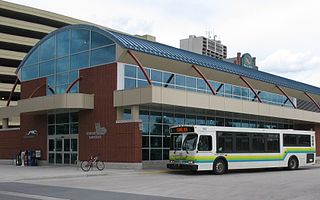
Transit Windsor provides public transportation in the city of Windsor, Ontario, Canada as well as LaSalle, Essex, Kingsville, Amherstburg and Leamington and serves more than 6 million passengers each year, covering an area of 310 km2 (120 sq mi) and a population of 235,000. They operate a cross border service between the downtown areas of Windsor and Detroit, Michigan via the Tunnel Bus, and service to events at Detroit's Comerica Park, Little Caesars Arena, Huntington Place, and Ford Field. The Windsor International Transit Terminal neighbours with the Windsor International Aquatic and Training Centre.

Toronto and Scarboro' Electric Railway, Light and Power Company was established in August 1892 to provide street railway service to the Upper Beaches district within the City of Toronto, Ontario and to the neighbouring Township of Scarborough. Except for two branches, the line ran as a radial along Kingston Road.
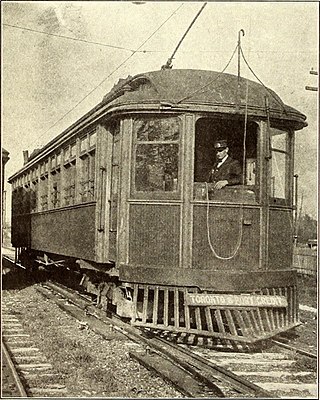
The Toronto and Mimico Electric Railway and Light Company was incorporated in 1890, and operated the Mimico radial line in the Toronto area. The line started operation in 1892 as a short suburban line that later was extended to Port Credit. In 1904, the railway was acquired by the Toronto and York Radial Railway (T&YRR) and became the T&YRR Mimico Division. In 1922, the City of Toronto acquired the T&YRR and contracted Ontario Hydro to manage the four T&YRR lines including the Mimico line. In 1927, the TTC took over the operation of the Mimico line and extended its service eastward to Roncesvalles Avenue. In 1928, the TTC double-tracked the line from Humber to Long Branch and made that portion part of the Lake Shore streetcar line. The portion beyond Long Branch to Port Credit became the Port Credit line, and continued operation as a single-track radial line until its closure on February 9, 1935.

Streetcars or trolley(car)s were once the chief mode of public transit in hundreds of North American cities and towns. Most of the original urban streetcar systems were either dismantled in the mid-20th century or converted to other modes of operation, such as light rail. Today, only Toronto still operates a streetcar network essentially unchanged in layout and mode of operation.

Peterborough Transit is the public transport operator for the City of Peterborough, Ontario, & Township of Selwyn, Ontario.
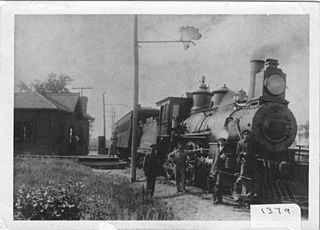
The Schomberg and Aurora Railway was a 36 km long railway in Ontario, Canada, running from the town of Schomberg to Oak Ridges, just south of Aurora. It connected Schomberg to the Metropolitan Line of the Toronto and York Radial Railway (T&YRR) tram service running along Yonge Street, and from there into the Toronto city proper. The service ran for 25 years between 1902 and 1927; the rails were pulled up shortly thereafter.

Beginning operation in 1861, the Yonge streetcar line was the first streetcar line in Toronto and the first in Canada. It started off as a horsecar line and closed in 1954 operating two-unit trains of Peter Witt motors pulling a trailer. Under the Toronto Transportation Commission, the Yonge line was the busiest and most congested streetcar line in the city leading to its replacement in 1954 by the Yonge Subway line, also Toronto's first and the first in Canada.

Toronto-gauge railways are tram and rapid transit lines built to Toronto gauge, a broad gauge of 4 ft 10+7⁄8 in. This is 2+3⁄8 in (60 mm) wider than standard gauge of 4 ft 8+1⁄2 in which is by far the most common track gauge in Canada. The gauge is unique to the Greater Toronto Area and is currently used on the Toronto streetcar system and the Toronto subway, both operated by the Toronto Transit Commission. As well, the Halton County Radial Railway, a transport museum, uses the Toronto gauge so its rail line can accommodate its collection of Toronto streetcars and subway trains. Several now-defunct interurban rail systems also once used this gauge.



















